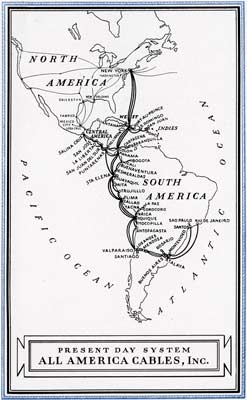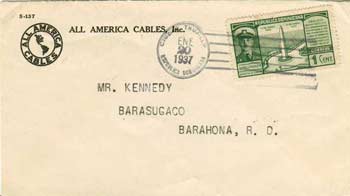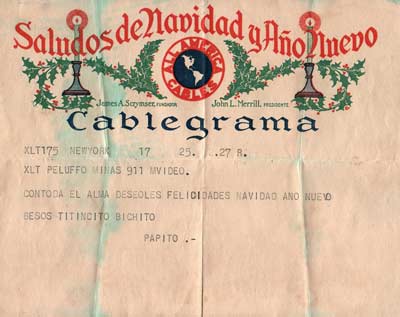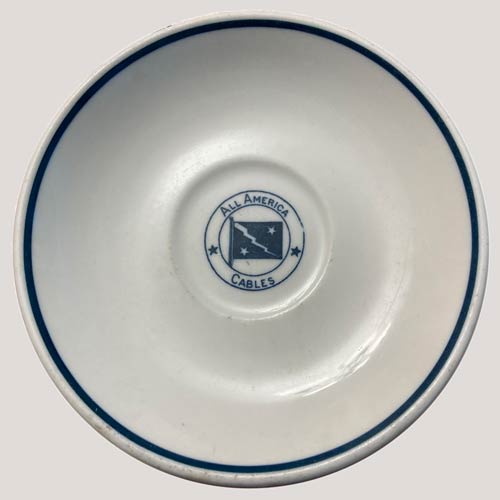|
ALL AMERICA CABLES
In 1867 James A. Scrymser's International
Ocean Telegraph Company laid the first line from Florida to Cuba,
235 miles. In 1878 Scrymser incorporated the Mexican Cable Company, and
the following year the Central and South American Cable Company, the predecessors
of All America Cables, Inc. The names were changed shortly afterwards
to the Mexican Telegraph Company and the Central and South American Telegraph
Company, and the cable routes were expanded over the years to link the
US to all of South America.
All America Cables, Inc. became the formal name of the companies in February 1920. According to the 1928 book on the company's history, “A Half Century of Cable Service to the Three Americas”:
Early in 1917, a new name for the companies had been a topic for discussion at several Directors' meetings, inasmuch as the titles, “Central and South American Telegraph Company” and “Mexican Telegraph Company” entirely excluded the United States and Canada, and were too cumbersome for public use. Another name was sought to designate more accurately the character and scope of the service, and also provide a caption combining the routing directions “Via Galveston” and “Via Colon.” To this end, “The Three Americas Cables” was considered, but lacking euphony, the title was rejected. Finally, when “All America Cables” was suggested, the idea was immediately favored.
In December 1917 the caption “Via All America” was first used, and on February 16 1920, “All America Cables, Incorporated” was formally adopted as the corporate name in lieu of the Central and South American Telegraph Company. The Mexican Telegraph Company retained its own identity and remained a part of the system until 1927, when the controlling interest was sold to the Western Union Telegraph Company.
New cables were laid in 1920, starting with one across the River Plate between
Atalaya, Argentina and Montevideo, Uruguay. Two further cables were laid
over the same route later in the year. These were manufactured by Telcon
and laid from the locally-chartered vessel Caceres by the crew of CS Colonia. Colonia
then laid a cable from Atalya to Rio de Janeiro, 1270 nm and Montevideo
to Santos, Brazil 1068 nm.
Also in 1920, Siemens Bros, using CS Faraday
(1), laid cables from Colon to Cartagena, Colombia; Santa Elena, Ecuador
to Chorillos, Peru, and Cuba to Puerto Rico.
In 1921 a one-reel short film on the operations of the company, titled “Linking the Three Americas,” was made for All America Cables by Frederic M. Dowd Productions. No copies of this film are presently known to exist, and all that remains is the review below from Educational Film Magazine, December 1921.
Also in 1921, Telcon, using CS
Stephan, connected Havana to Miami, and in 1924/25 Colonia laid
a triplicate New York- Fisherman's Point (Cuba)-Colon cable.
|

Original System Map |

1928 System Map |
In 1926 All America purchased the US-Haiti Telegraph
Company from La Compagnie des Câbles Télégraphiques.
New cables were laid: Willemstad - La Guayra, Willemstad - Aruba, Aruba
- Maracaibo and Maracaibo - Barranquilla. Telcon manufactured the cables
and used CS Dominia to lay them.
|

1930s “Via All America” blotter with the company’s American Indian Signal Fires motif and system route map.
Thanks to site visitor Angela
Walters
for providing the scan. |
In February 1927 All America Cables was acquired by the International Telephone and Telegraph Company (I.T. & T., later ITT). In 1938 the division name was changed to All America Cables and Radio, and together with the Commercial
Cable Company and Mackay Radio & Telegraph, All America was now part of the American Cable and Radio Corporation, of which ITT was the major shareholder.

1937 All America Cables Cover |
CABLESHIP
See the separate page on CS
All America
All America Cables Christmas Cablegram

|
 |
 |
The Fiftieth Anniversary Medallion

All America Cables |

From the First Signal Fires
to All America Cables
Commemorating Fifty Years
of Service to the Americas
1878 May 28 1928 |
50th anniversary medallion,
designed by Julio Kilenyi
and produced by
Whitehead
and Hoag.
212 grams, 83mm diameter.
|
On Tuesday, May 8 [1928], President Merrill called to his office all members of the New York staff and presented each individual with a medallion, commemorating the Fiftieth Anniversary of the founding of All America Cables, Inc. He shook hands with each person and thanked every man and woman for the faithful service he or she had performed for All America Cables. Medallions for the employees outside of New York are being sent to the various stations and should be in the hands of all within another month.
The medallion is a singularly beautiful thing and everybody was impressed by its attractiveness. The design was executed by Mr. Julio Kilenyi, an artist and sculptor of international fame. Mr. Kilenyi first studied at the Royal Fine Arts School in Budapest and continued his studies in Germany and in France.
After considerable work in Europe, he went to South America and spent several years in Buenos Aires where he established an enviable reputation as a portrait sculptor. He came to the United States about ten years ago.
In medallic art some of his most celebrated examples have been the portraits of Woodrow Wilson, General Pershing, Thomas A. Edison, Elbert H. Gary, Mark Twain, Charles W. Elliott, and Lord Northcliffe. He designed the President Coolidge Inauguration Medal also. In addition to these he has made medallic portraits of many other dignitaries of the Church and of many who are celebrated in the Commercial world.
Among the models which Mr. Kilenyi has executed and from which medals have been struck are those for the Official Lindbergh medal, the Byrd North Pole medal, the Curtis N-C 4 Atlantic Flight medal, the Battle of Bunker Hill medallion, the Battle of Lexington medallion, the Plymouth Tercentenary medal, and the Republic of Peru Centenary medal.
[Source: All America Review, June 1928]
This All America Cables dinner plate was discovered in late February 2022 in Broad Channel, Queens, New York City, during an extremely low tide.
 |

O.O.CO.
SYRACUSE
CHINA
F-11
|

ALL AMERICA
CABLES
|
The plate was found in an area where a colony of homes and businesses on stilts once stood out in the water. Called “The Raunt,” it was a fisherman village that existed from the late 1800s until the mid 1950s. It was only accessible by boat or by Long Island Rail Road train, which stopped on an elevated platform dead center in town.
A number of cables landed in this area, at Rockaway Beach and Manhattan Beach, but it is not known how the plate came to be where it was found.
Thanks to site visitor Maurício Ganzo Pereira of Brazil for providing this image of an All America Cables cigarette lighter.
Linking the Three Americas [a short film released in 1921]
An interesting feature of the lecture given by Dr. A.N. Goldsmith of the College of the City of New York before the American Institute of Electrical Engineers on November 17 [1921]was the first showing of a new one-reel informational motion picture, Linking the Three Americas, made for All America Cables Inc., by Frederic M. Dowd Productions.
The picture covers the entire story of the operations and service of the All America over its 25,000 miles of submarine lines between the United States and the countries of Central and South America and the West Indies.
The familiar red, white and blue insignia of “All America Cables” reproduced in colors leads up to a contrast between the old Indian signal fires and the modern system of cable transmission. The scope of the All America system is developed through an animated map showing the extent of the lines and the points at which the landings are made. This is followed by scenes of cable laying, both deep sea and inshore, including a technical animated visualization of the construction of deep sea and inshore cable.
Then the proper way of preparing a cable code message is shown by contrasting pictures, preceding a complete demonstration, by picture and animation, of the modern automatic method of cable transmission. The sending operator places the message in the rack over his typewriter-like machine and strikes the corresponding letters on the key-board. Each letter struck produces a series of perforations in the narrow paper strip passing through the head of his machine. This strip immediately enters the transmitting machine where the perforations are transformed into electric impulses that are placed on the cable and the message is on its way. As a precaution against errors in transmission the strip then runs through a “baby” recording machine enabling the sending operator to at once see the message as it will reach destination and detect any mistake, though mistakes are rare.
Another animated map shows the message actually traveling from New York to Rio de Janeiro, impressing the observer with the speed attainable by the cable method of international communication, bringing points at five and six thousand miles distance within thirty or forty minutes of New York. The value of this dispatch in commercial and diplomatic transactions is incalculable.
At destination electric impulses pass from the cable into the recorder and register on another narrow paper strip a wavy ink line, the so-called “cable language,” that the receiving operator translates into the original code words.
Throughout the transmission demonstration close-up photographs disclose the technical operation of the automatic instruments, making cable-sending perfectly clear to the student or layman. The detection of breaks in the line and the method of repairing or splicing broken cable is covered at length in animation and diagrams.
The picture closes with a score of scenes in the large cities of South America served by this American-owned and American-directed company.
The educational value of Linking the Three Americas is evident and the picture seems eminently suitable for class and school use as well as for exhibition before trade and export associations, manufacturers, and other business bodies for which purpose it was primarily intended.
Distributed by the All America Cables, Inc., 89 Broad St., New York City.
[Source: Educational Film Magazine, December 1921]
For personal stories of life
at All America Cables, see
Captain Frederick Hack and CS All America and
George S. Watson's Remembrances
of a Cable Operator
Other material on the company may be found
by searching the site for “All America” below
|

